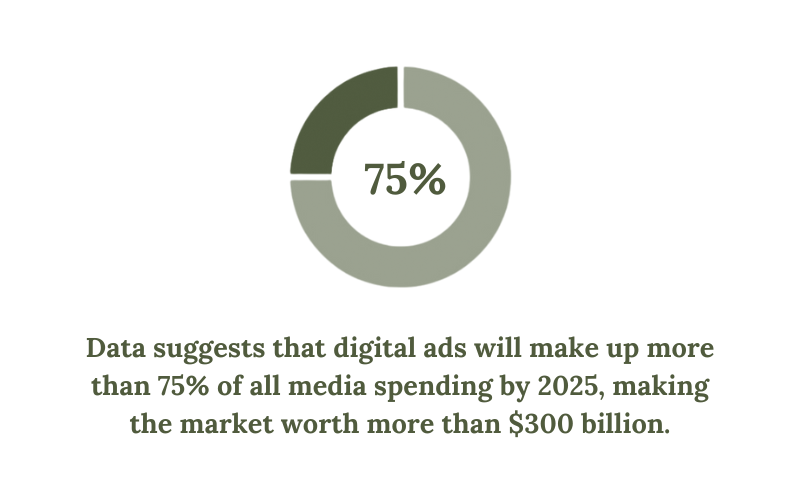Ever notice those eye-catching ads with pictures and sometimes even short videos that you see while browsing websites? Those are display ads! They’re like little billboards on the internet, there to grab your attention and tell you about a cool product or service.
These display ads can come in all shapes and sizes. Some are just simple pictures, while others might be fancy animations or even have little games you can play. The kind of ad an advertiser uses depends on what they’re trying to achieve. Some might just want to get your name familiar with their brand, while others might want you to click right over to their website to buy something.
No matter what the format, display advertising is a powerful tool for businesses to reach a wide audience online. It’s like having a salesperson follow you around the web, but in a way that’s way less annoying.

Marketing’s gone digital, and to win, you gotta know it! Display ads are a great first step – like online billboards to grab attention. Perfect for beginners in the digital marketing game!
Types Of Display Advertising
These ads come in all shapes and sizes, targeting different folks and functioning in various ways. Let’s break down the different options and see what each one brings to the table.
Remarketing Ads
Have you noticed those ads that seem to follow you around online? They’re called display advertising, and a lot of them are actually remarketing ads, also known as retargeting ads. They’re pretty smart – they track your browsing behavior and then show you ads based on what you’ve been looking at.
hy do companies use them so much? Well, it turns out, they work! According to Accenture Interactive, a whopping 91% of us prefer buying from brands that remember what we’re into and offer stuff tailored to our interests. So, these ads are like your personal shopping assistant, making suggestions based on what you’ve been eyeing. Here’s how they work:
- Stick a teensy-weensy piece of code on your website. This little guy keeps tabs on what visitors are checking out, like which pages they’re clicking on and what products they’re eyeing.
- Use all that info you’ve gathered to create lists of different types of customers and figure out what ads would tickle their fancy the most.
- Start cranking out those display ads! Tailor them to match the interests of the folks you’ve been spying on.
And voilà! You’ve got yourself a dynamic remarketing campaign. It’s like magic, keeping your brand on the radar of folks who’ve already shown some love for what you’re selling.
Personalized Ads
Google sees remarketing as a subset of personalized advertising, which can work wonders when you tailor your audience for a smoother user journey. Personalized ads aim at reaching folks based on their demographics and online interests. You can even whip up ads suggesting products personalized to what users have been eyeing on your site lately.
Aside from remarketing, Google breaks down personalized ads into four other categories. These ads tap into general user behaviors and preferences, rather than focusing on interactions with specific brands, as targeting criteria.
Affinity Targeting
Affinity targets folks who are really into your niche. These groups can be pretty wide, think “car buffs” or “movie fanatics”, so you can connect with a bunch of people who are already interested in what you offer.
Custom Affinity Groups
Tapping into custom affinity groups like “long-distance runners” or “tulip growers” let you really zero in on the interests you’re aiming for. Just keep in mind, going narrower means reaching a smaller crowd overall.
Custom Intent & In-market Ads
So, when you opt for custom intent and in-market ads, you’re honing in on folks actively seeking what you offer. Sure, you might not hit as many eyes as with broader targeting like affinity or custom affinity, but the ones who do spot your ad are likely itching to buy. Just remember, narrowing your focus means reaching fewer peeps overall.
Similar Audience Ads
So, you know those ads that seem to know exactly what you’re into? That’s all thanks to similar audience ads! Basically, they’re like your current website visitors’ posse – Google matches their interests or traits with other potential visitors. How? Well, Google takes a peek at the profiles of folks on your remarketing lists and compares them with others, spotting the similarities. That’s how they nail those display advertising campaigns that hit home for your audience!
Contextually Targeted Ads
So, instead of just tossing your ads out there based on who someone is, contextual display advertising puts them where they’re likely to be noticed. It works like this:
- Your ad’s all about camping gear? Great, we’ll put it where outdoor enthusiasts are hanging out.
- You prefer English ads, or maybe you want them to show up only in certain locations? We can handle that.
- Is the website all about travel? Perfect fit for your vacation packages ad.
- And hey, we even peek at what people have been clicking on recently to make sure your ad gets in front of the right eyes.
You’ve got options too. You can trust Google to do all this heavy lifting for you, or you can dive in yourself and pick the topics you want to target. It’s your call!
Topic Targeting
So, with Google’s setup, you get to choose topics that align with your ad, and then it does the legwork of finding the right spots for it across the Display Network or YouTube. Plus, you can say no thanks to topics that aren’t hitting the mark or have nothing to do with what you’re promoting.
Think of topic targeting as a buddy to affinity targeting, but instead of connecting with users, your ads get cozy with relevant websites.
Display Ads vs Native Ads
You know, when you think about it, display advertising has been around forever, both online and offline. I mean, the first internet display ad goes way back to 1994, courtesy of AT&T. And let me tell you, they’ve only been growing in popularity since then!
But hold on, there’s this new kid on the block called native advertising that’s been snagging some of display advertising’s spotlight. Native ads? Yeah, they’re like chameleons, blending right in with the rest of the content on a page. You’ve probably seen them a lot in your social media feeds, looking just like regular posts. Sneaky, right? Well, they’re legally bound to slap a “sponsored” label on them to keep things above board.
The thing with native ads is, they’re not as in-your-face as display ads. And get this, they can even slip past those folks with ad blockers on. Crafty, huh? People tend to respond better to content when it doesn’t scream “I’m an ad!”, so native ads can really reel in potential customers.
But here’s the kicker: there’s always the risk of folks feeling duped when they realize that cool post they enjoyed was actually just an ad in disguise. And let’s not forget the challenge for marketers: hiding their brand info too well. Sure, the message might stick, but if nobody remembers who sent it, what’s the point? Tricky business, this advertising game.
How To measure Display Ad Performance
To ace your display advertising game and make those marketing dollars count, it’s crucial to gauge how effective your ads are. Whether you’re rocking Google Ads or another platform, keeping tabs on your campaign’s performance is key. Here’s the lowdown on what to watch out for:
- Impressions: Think of these as the number of times your ad pops up on a website. Ideally, you want this number to climb throughout your campaign, showing that you’re reaching a wider audience.
- Reach: Don’t mix this up with Impressions. Reach is all about the number of actual people who laid eyes on your ad. Impressions might rack up each time your ad shows, but Reach counts the individual viewers.
- Cost: Keep your budget in check and watch your spending. Measure the total campaign cost, along with metrics like cost per click (CPC) or cost per thousand impressions (CPM). Display ads usually go by CPM.
- Click-Through Rate (CTR): This one’s about engagement. It’s the percentage of people who click on your ad compared to those who see it. Higher CTR means more folks are engaging with your display ads.
- Conversion Rate: This one’s a big deal because the whole point of advertising is to get folks to take action. Whether it’s making a purchase or signing up for a newsletter, conversion rate tells you how many people are actually following through from seeing your ad. Depending on your goals, you might have different conversion actions, but the bottom line is all about turning eyeballs into action-takers.
Final Word
Display ads might look fancy, but don’t be intimidated! They’re a super-powerful tool to get your brand out there to a ton of people online. From eye-catching visuals to those “follow-you-around” ads (we all know them!), display advertising lets you target the right folks and show them exactly what they need to see.
Need a hand? Our Paid Media Services has you covered. We create killer ads that grab attention (boring banners, begone!), target the right people for your brand, and keep your budget chill.
Let The Margator be your partner in crime! Contact us today for a FREE consultation and unlock the full potential of display advertising!

